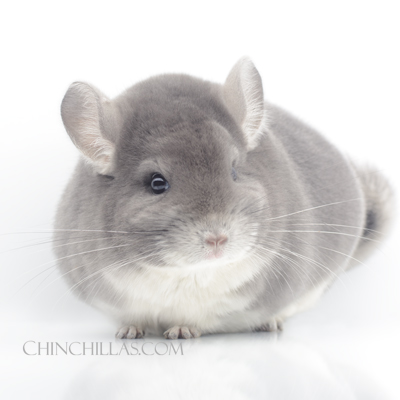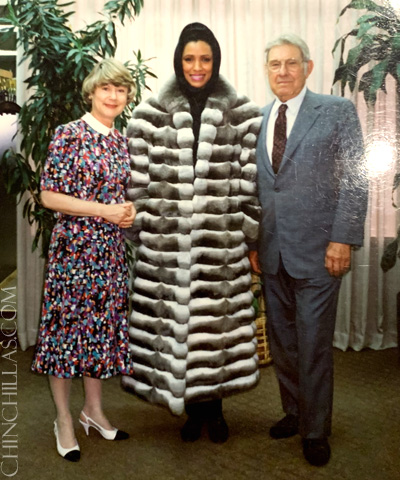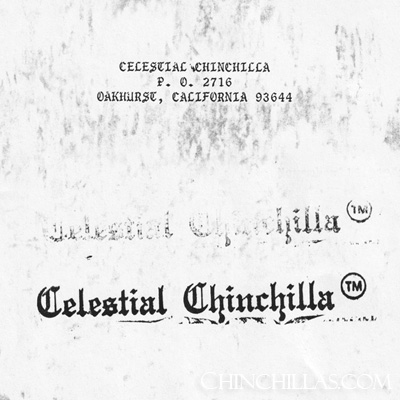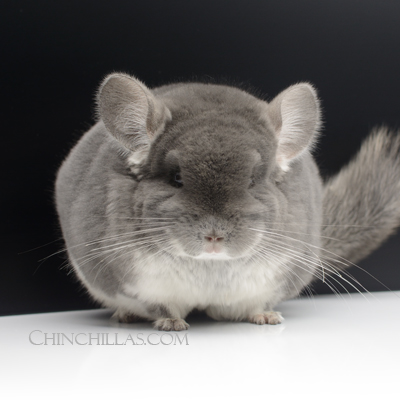The History of the Violet Chinchilla

(above) champion Violet male chinchilla
Please note that Chinchillas.com does not advocate for chinchilla pelt production, but is publishing the following article for its educational and historic value.
Part 1 of 3
Published Midsummer's Eve ~ June 20, 2025
The History of the Violet Chinchilla
The origin of the violet chinchilla, for 60 years, was one of the most closely guarded secrets in the chinchilla world. For decades, chinchilla breeders referred to an ‘Afro Violet’ potentially of Rhodesian origin, but little more was known.
 The mutation itself, a true recessive, went on to become the highest quality recessive in domestic chinchilla herds. The color is a violet hued dusky grey, with a particular sheen which some furriers compare to the guard hair of mink. In chinchilla, the violet is the only color with such a sheen. The mutation had the advantage of early development in a series of outstanding Standard chinchilla herds; beginning with the herd in which it mutated, then the Sullivan Chinchilla herd, and finally with PSK Chinchilla rounding out the trifecta.
The mutation itself, a true recessive, went on to become the highest quality recessive in domestic chinchilla herds. The color is a violet hued dusky grey, with a particular sheen which some furriers compare to the guard hair of mink. In chinchilla, the violet is the only color with such a sheen. The mutation had the advantage of early development in a series of outstanding Standard chinchilla herds; beginning with the herd in which it mutated, then the Sullivan Chinchilla herd, and finally with PSK Chinchilla rounding out the trifecta.
Loyd Sullivan, born in about 1917, began dabbling in breeding chinchillas and dressing pelts in the 1940s. He was good friends with Eddy Hughes, a well-known chinchilla grader and judge at the time, and with Reginald 'Reg’ Chapman, son of Mathias Chapman. Loyd and Reg were about the same age. Reg was a pilot, and owned a small private plane which the two frequently traveled in together. By the 1960’s, Loyd was traveling extensively for chinchilla related business, including to Africa, where he lectured, judged, gave seminars, and taught the finer points of breeding and fur dressing. The original pelts Loyd imported from Africa were high quality and heavily furred.
 (pictured l-r) Loyd's second wife Patricia Sullivan, a model wearing a full length chinchilla coat, and Loyd Sullivan at the Grand Hotel in Orange City, California circa 1985.
(pictured l-r) Loyd's second wife Patricia Sullivan, a model wearing a full length chinchilla coat, and Loyd Sullivan at the Grand Hotel in Orange City, California circa 1985.
Photo courtesy PSK Chinchilla archives
Also during the 1960s, a young California couple, Pete and Sue Kiseskey, decided to get involved with chinchillas. It wasn’t long before Pete and Sue befriended Loyd, Eddy, Reg, and others. Pete and Sue soon launched PSK Chinchilla, which would later become world famous. At the time when PSK was located in Cummings Valley, CA, Mathias Chapman owned property one valley over, both being located in Kern County. And Reginald owned property in Big Bear, CA which was snowy and cold. So when Loyd bought property in Oakhurst, Reginald did too. They were all good friends. For many years Pete served as the President of the leading US pelting organization, and Pete and Sue both judged chinchillas in the US & overseas. Additionally they were skilled pilots and owned their own plane. PSK was known universally for its outstanding breeding stock, and Sue in particular for her beautiful Black Velvets.
Loyd imported the Violet chinchillas into the United States in the 1970’s (see Mr. X and the Violet Chinchilla for a full account). The Kiseskeys passed the time with Loyd while the animals were en route, and Sue recalls Loyd “having a nervous breakdown” during the import. Loyd was particularly concerned about the refueling stop near the equator in Lagos, Nigeria. “Loyd picked them up at LAX, and went straight to Oakhurst. They were hearty and all survived,” recalled Sue. “Loyd got no records with the animals, but was happy he got the herd.”
According to Sue, Loyd’s early Violet pelts were quite nice. She said, “Loyd bred the Violets to everything: white, black, charcoal, he tried every color you can imagine, trying to figure them out.” The initial Sullivan Violet pelts were marketed as ‘Blue,’ bringing as much as $400 per pelt in Europe.  To stop the confusion or potential fraud regarding multiple names being used by brokers and others for marketing purposes, Sullivan Chinchilla, and later PSK Chinchilla, trademarked the name 'Celestial Chinchilla' as the official name for the Violet pelts, just as the black pelts had been marketed as 'Black Velvet,' and the first hybrid pelts, the TOV Beige, had been marketed as 'Touch of Velvet' in the fur market.
To stop the confusion or potential fraud regarding multiple names being used by brokers and others for marketing purposes, Sullivan Chinchilla, and later PSK Chinchilla, trademarked the name 'Celestial Chinchilla' as the official name for the Violet pelts, just as the black pelts had been marketed as 'Black Velvet,' and the first hybrid pelts, the TOV Beige, had been marketed as 'Touch of Velvet' in the fur market.
The decade of the 1980’s was the Golden Era for chinchilla pelting organizations, breeding, and shows in the US. It was an optimal time for Loyd to market the Violets. Between 1984 and 1988, Loyd began selling the Sullivan Violet chinchillas to prominent breeders in the USA including Bowen's Chinchilla Ranch, Maynard Beitz, Eugene Laporte, Dr. James Lauridsen, Dr. F.G. Appleton, Vin Somavia, and others. Loyd exported the Violets to Argentina, Canada, England, Germany and West Germany. The price was a steady $2,500 per chinchilla (or $7,700 in 2025). Surviving herd records reflect over $65,000 in sales (being equivalent to about $200,000 in 2025). The extent of sales in which the records were lost is unknown.
In 1988, Loyd was having health problems and spent the better part of a year in the hospital. Pete and Sue bought the Sullivan Violet herd from Loyd in the early 1990s. It consisted of two to three hundred chinchillas; some Violets and mostly Violet carriers, expanding the PSK herd to 3,000 chinchillas. Pete and Sue primarily crossed Violet to Standard, and Violet to Standard (violet carrier). Sue emphasized that clarity is very important in the Standards selected to cross with Violets: “You cannot breed an off color animal to a violet and get clarity.” Further, she said that color phase, light, medium, or dark doesn’t matter, that clarity should be emphasized when producing any color phase of Violet. Additionally, “pay attention to the veiling” in the Standards. Sue stressed checking the underfur in the Violets, noting that the underfur color had a lot to do with their overall color. Further, the early Violet breeders had a term; ‘monkey faced,’ for Violets that didn’t have sufficient veiling on the face or head. The Standard (violet carriers) could be good or bad, but they often had a lack of fur – they had good fur strength, but lacked density.
 (pictured) TOV Violet Chinchilla (Black Velvet / Violet hybrid)
(pictured) TOV Violet Chinchilla (Black Velvet / Violet hybrid)
Sue described the TOV Violet as having a different kind of fur. The TOV Violet’s lack of a bar makes them distinguishable from the Violets. PSK’s Violets did not have many belly (clarity) problems, but PSK’s Standard herd in general was strong for producing ‘clarity on top’ and also white bellies. At PSK, the occasional Sullivan Beige would pop out of the Violets. The Sullivan Beige, also a true recessive, had bright ruby eyes and “no fur.”
The Violets were relatively hearty and also prolific. Sue recalls that it was difficult to get consistent good quality every time, even after outcrossing, including when outcrossing to Standards as good as show Standards. One early breeder in particular who was well known for producing truly exceptional Violets was Maynard Beitz of Colorado. Many of Maynard’s best Violets came from his carrier x carrier crosses.
Years later, when Pete and Sue began downsizing their herd, the majority of their Violets were sold to Gary Neubauer in the US, and to Mario and Maria Marcon in Buenos Aires, Argentina.
And that was the end of the story of the early Violet, until now:
The Finding of Mr. X and the Gillingham Violet Chinchilla
Associated article:
Mr. X and the Violet Chinchilla, by Loyd Sullivan
Visit the Chinchillas.com Auction database to view additional pictures of Violet and Violet hybrid chinchillas, or see new Violet chinchillas for sale in the Sales Gallery.